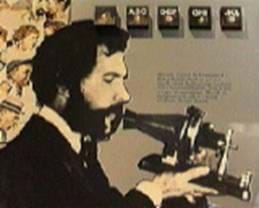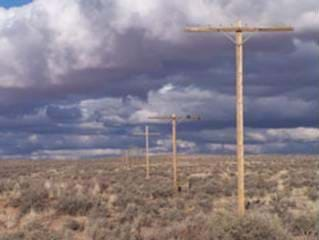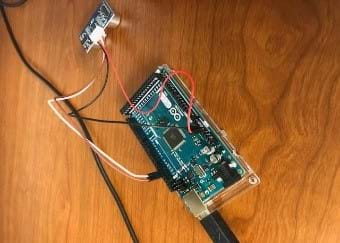Quick Look
Grade Level: 4 (3-5)
Time Required: 15 minutes
Lesson Dependency: None
Subject Areas: Science and Technology

Summary
Students are introduced to communications engineers as people who enable long-range communication. In a demonstration, students discuss the tendency of sound to diminish with distance and model this phenomenon using a slinky. Alexander Graham Bell is introduced as the inventor of the telephone and a pioneer in communications engineering.Engineering Connection
Communications engineering extends back to at least the invention of the telegraph in 1840. Yet perhaps the most famous communications engineering invention is the telephone that came a few decades later. Contemporary communications engineers are responsible for telephones and (wireless) cell phones, as well as communication via the internet.
Learning Objectives
After this lesson, students should be able to:
- Describe sound as a wave that diminishes in strength as it travels.
- Name the engineer that invented the telephone.
- List an impact of the telephone on people or society.
Educational Standards
Each TeachEngineering lesson or activity is correlated to one or more K-12 science,
technology, engineering or math (STEM) educational standards.
All 100,000+ K-12 STEM standards covered in TeachEngineering are collected, maintained and packaged by the Achievement Standards Network (ASN),
a project of D2L (www.achievementstandards.org).
In the ASN, standards are hierarchically structured: first by source; e.g., by state; within source by type; e.g., science or mathematics;
within type by subtype, then by grade, etc.
Each TeachEngineering lesson or activity is correlated to one or more K-12 science, technology, engineering or math (STEM) educational standards.
All 100,000+ K-12 STEM standards covered in TeachEngineering are collected, maintained and packaged by the Achievement Standards Network (ASN), a project of D2L (www.achievementstandards.org).
In the ASN, standards are hierarchically structured: first by source; e.g., by state; within source by type; e.g., science or mathematics; within type by subtype, then by grade, etc.
International Technology and Engineering Educators Association - Technology
-
Communication technology is the transfer of messages among people and/or machines over distances through the use of technology.
(Grades
3 -
5)
More Details
Do you agree with this alignment?
State Standards
Colorado - Science
-
Identify and describe the variety of energy sources
(Grade
4)
More Details
Do you agree with this alignment?
Pre-Req Knowledge
Students should be familiar with sound being described as a wave. This lesson works well accompanying a science unit on sound or waves.
Introduction/Motivation
(For a simple demonstration as part of this introduction, have handy a metal slinky and a [approximately] five-foot long, small-diameter PVC pipe [or other kind of rod].
Can you hear me now? (Students should answer affirmatively.) If we were outside on opposite sides of the playground, would you be able to hear me? (Answer: No) Why is that? (Expect various answers.) Sound waves tend to lose their power as they travel. Let's take a look at a model.
(Pick up a metal slinky and place it over the rod. Have a volunteer hold onto the other end of rod. Stretch the slinky across the rod and ask volunteer to firmly hold his/her end of the slinky. Push abruptly on the slinky from your end to create a wave that moves from side to side.)
Notice how the wave moves across the slinky. This is similar to how sound waves move through air and solids. Do you see how the wave starts out strong and tends to die out on the other end? The wave is given energy at the beginning, but that energy is used up as the wave travels through the slinky. Let's see it again. (Demonstrate the wave again.) The slinky steals the energy that is given to the wave.
Now imagine that on the other end of the slinky is your ear. Also imagine that my mouth is on my end. As I talk, I produce waves in the air that travel to your ear. What does the slinky represent? (Answer: The air.) So that is how sound travels: from my vocal chords to your ears in the form of waves that decrease in strength with distance. Refer to the associated activity String Telephones to illustrate with a hands-on experiment to illustrate how sound travels through both string and air by developing string telephones.

Do you think it would be helpful to be able to speak with someone who is far away from you, maybe in another city? You think yes? Well, you are not the only ones. What is the invention that allows us to do this? (Answer: The telephone;.) Do you know who invented it?
(Optional - Print out the following paragraph and read it as a class.)
Alexander Graham Bell (1847–1922) was a communications engineer and inventor who, like his family, had a lifelong fascination with sound. Both his father and grandfather taught people how to speak more clearly, including the deaf. Bell's mother was deaf, and while others would speak to her through an ear tube (a cone-shaped device that makes sounds louder), young Alexander decided to speak in a low voice at her forehead. Alexander devoted much of his life to helping people hear and be heard. He is most famous for enabling people to hear each other over long distances by using telephones, which he invented in 1876.
How do you think Alexander's mother could hear him? (Answer: She could feel the vibrations of his voice.)
The name of this lesson is "Sound Extenders." Where do you think this name comes from? (Answer: The telephone "extends" sound over great distances.) What are some other "sound extenders?" (Answers: Cell phones, live television, video phones, loudspeakers.) The people who create and make available these "sound extenders" are known as communications engineers. They notice that sound dies down with distance, just as we notice it, and use their creativity to enable sound to travel greater distances. Alexander Graham Bell was one of the first communications engineers.
Lesson Background and Concepts for Teachers
A sound wave is often thought of as a pulse of energy. The wave travels by pushing on the medium it is moving through — air, liquid or solid. With each push on the medium, that portion of the medium pushes on the next portion and so on, thus creating the chain of pressures that is the sound wave. It takes energy to create a sound wave — to create movement that is opposed by friction. It is important to note that the energy is not destroyed as the wave travels along; rather, it is turned into a tiny amount of heat (this is the same phenomenon as rubbing your hands together: overcoming friction creates heat).

The less energy a sound wave has, the less loud it is when it strikes our ear. Therefore, a wave that has been traveling a great distance, though loud to the person nearby, could be quite soft to the person it finally reaches. Out of this characteristic of sound, and other limitations, the need for a telephone was perhaps recognized. A telephone does not record sounds and then replay them at the other end of the line. Rather, a telephone enables sound waves to be "extended" over a greater distance by translating them into a wave on an electric current. This translation is reversed at the other end of the line to create a wave through the air, which we are able to hear.
Associated Activities
- String Telephones - Students investigate how sound travels through both string and air by developing string telephones.
Lesson Closure
Why is the telephone a useful engineering achievement? Well, we know that the sound we hear gets quieter with distance, so we need things like telephones (or other engineered devices that "extend sound") to talk to each other from far away. How have telephones and cell phones made life easier? (Answers will vary, but may include: communications with family, friends and businesses far away.) Why do you think engineers like Alexander Graham Bell invent the things they do? Alexander Graham Bell wanted to help people hear each other and be heard. Many engineers design things that help other people. Engineers have improved Bell's original telephone over the years by making the sound clearer and the telephones portable.
Vocabulary/Definitions
acoustics: The study of sound; the characteristics of sound in an environment.
Alexander Graham Bell: Inventor of the telephone.
communications engineering: The branch of engineering having to do with developing and maintaining technology used for communication, such as telephones.
Assessment
Pre-Lesson Assessment
Poll: Before the lesson, ask all students:
- Who here uses a telephone? How many times a day? Week?
Write on the board how many people do and how many people do not.
Post-Introduction Assessment
Brainstorming: As a class, have students engage in open discussion. Remind them that in brainstorming, no idea or suggestion is "silly." All ideas should be respectfully heard. Encourage wild ideas and discourage criticism of ideas. Have students raise their hands to respond. Ask students
- What are cell phones useful for?
Lesson Summary Assessment
Engineering Impacts: Have students think about life before the telephone or cell phone. Ask them how the telephone has made a difference in people's lives. How have telephones helped families? Businesses? Schools? What are two limitations that engineers might think about in their design of telephones? (Hint: Materials, weight, size, etc.) How have these limitations affected how people use telephones?
Lesson Extension Activities
As a child, young Alexander Graham Bell displayed a natural curiosity about his world. Have students research Alexander Graham Bell. What was the path that led him to become an inventor? Have students write stories about Alexander set in modern times. What might he be curious about? What might he invent?
Subscribe
Get the inside scoop on all things TeachEngineering such as new site features, curriculum updates, video releases, and more by signing up for our newsletter!More Curriculum Like This

Students learn about sound and sound energy as they gather evidence that sound travels in waves. Teams work through five activity stations that provide different perspectives on how sound can be seen and felt.

Students are introduced to sound energy concepts and how engineers use sound energy. Through hands-on activities and demonstrations, students examine how we know sound exists by listening to and seeing sound waves

Students investigate how sound travels through string and air. They are given a design challenge to redesign the string telephone for distance.

Students learn vocabulary necessary for understanding how ultrasonic waves are reflected and refracted. Students also see how ultrasound technology is used in medical devices.
References
Gralnick, Jeff. "The Next New Thing is Here: Expanding Capabilities of Wireless Devices – The Newest Platform." March 1, 2006. eJournal USA, America.gov. Accessed November 27, 2010. http://www.america.gov/st/democracyhr-english/2006/March/20080818201945xjsnommis0.6300623.html
National Institutes of Health, Department of Health and Human Services, National Institute of Environmental Health Sciences, NIEHS Kids' Pages, "Let's Go to a Party Puzzles!" January 22, 2008. Accessed July 24, 2008. http://kids.niehs.nih.gov/science/quizzes/party.htm
U.S. Department of the Interior, National Park Service, Petrified Forest, "Historic Route 66," January 26, 2007. Accessed July 24, 2008. http://www.nps.gov/pefo/historyculture/historic-route-66.htm
Copyright
© 2008 by Regents of the University of Colorado.Contributors
Michael Bendewald; Malinda Schaefer Zarske; Janet YowellSupporting Program
Integrated Teaching and Learning Program, College of Engineering, University of Colorado BoulderAcknowledgements
The contents of these digital library curricula were developed by the Integrated Teaching and Learning Program under National Science Foundation GK-12 grant no. 0338326. However, these contents do not necessarily represent the policies of the National Science Foundation, and you should not assume endorsement by the federal government.
Last modified: July 1, 2019









User Comments & Tips